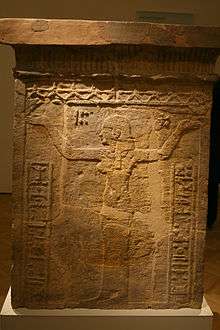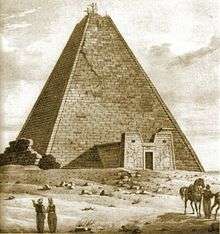Wad ban Naqa

Wad ben Naga (also Wad Ban Naqa or Wad Naga) is the name of an ancient town of the Kushitic Kingdom of Meroë in present-day Sudan. The village lies on the eastern bank of the Nile, about 80 kilometers upstream of Meroë and about 40 km southwest of Shendi. It is not to be confused with the ruins of Naqa which are also located south-west of the ancient site in the region.
History

The place is so far little explored. The earliest known building on the site is a very large, two story brick palace built by Queen Amanishakheto (first century AD) whose large pyramid in the royal cemetery at Meroe (BEG N 6) contained a hoard of gold jewellery found in the early 19th century by the Italian treasure hunter, Giuseppe Ferlini (NB: several references to this site erroneously identify the pyramid as having been built at Wad ben Naga).
Karl Richard Lepsius (1843) discovered and brought back to the Berlin Museum a barge pedestal depicting King Natakamani and Amanitore. It contained Meroitic script and Egyptian hieroglyphs which led to the identification of the phonetic values for the letters of Meroitic cursive script by Francis Llewellyn Griffith (1911). This inscription was later interpreted by scholars to mean "Stay, stay on the great throne, Isis, mistress of the Underworld, like the living sun-disk in the horizon, in that you let your son Natakamani remain on his throne." "Stay, stay on the great throne, Isis, mistress of the Underworld, as does the moon that grows like an egg in traversing heaven. May it give life to your daughter, Amanitore." [1]
South of the palace is a circular building of unknown function, whose walls are still up to 5 m high. There was a temple of Isis that has now been destroyed. Nearby was small temple with columns with the god Bes carved on them that might have functioned as a divine birth house (mammisi). It was probably built by Natakamani and Amanitore (first century AD). There are the remains of several other unexplored temples at the site in addition to the one dedicated to Isis. New excavations at the site began in 2009 under the direction of the National Museum of the Czech Republic.
Notes and references
- ↑ Wildung (1997), p. 256
Bibliography
| Wikimedia Commons has media related to Wad Ban Naga. |
- Wildung, Dietrich (1997), Sudan: Ancient Kingdoms of the Nile
- Wenig, Steffen : Die meroitische Königin Amanitore. Barkenuntersatz aus Wad Ban Naqa (Sudan), um 20 u.Z., Nr. 7261. Neue Museumskunde 20 (2) (1977), S. 82
- The temple of Apedemak in Naqua. In László Török (2002). The image of the ordered world in ancient Nubian art: the construction of the Kushite mind, 800 BC-300 AD. BRILL. ISBN 978-90-04-12306-9. Retrieved 30 May 2011. S. 226f.
Coordinates: 16°30′40″N 33°06′44″E / 16.51111°N 33.11222°E